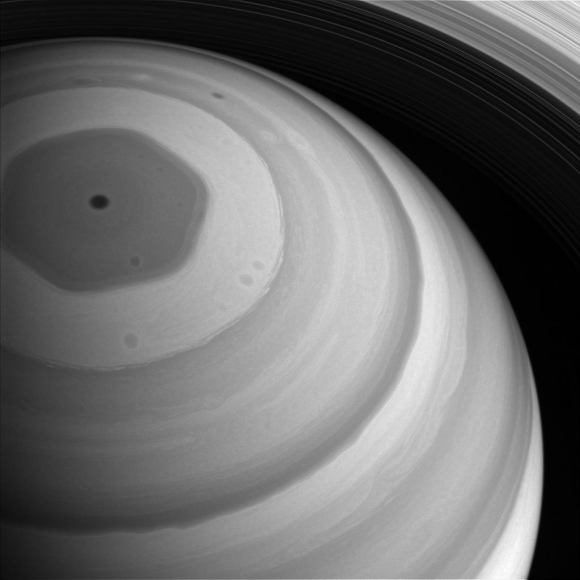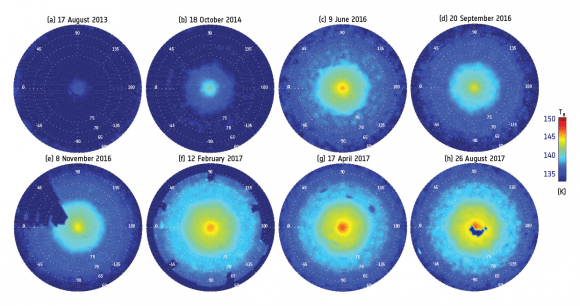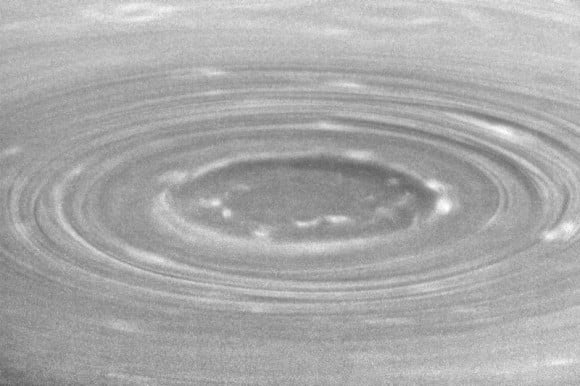A new study based on data from the
Cassini mission
is revealing something surprising in the atmosphere of Saturn. We've known about the storm at the gas giant's north pole for decades, but now it appears that this massive hexagonal storm could be a towering behemoth hundreds of kilometers in height that has its base deep in Saturn's atmosphere.
[caption id="attachment_139945" align="alignnone" width="580"]
This grey-scale image of Saturn's northern polar vortex was captured by the Cassini spacecraft. This image was captured from a distance of about 1.2 million km. A portion of Saturn's rings are barely visible in the top right. Image: NASA/JPL-Caltech/Space Science Institute.[/caption]
When Cassini arrived at Saturn in 2004, it was summertime in the southern hemisphere, and the spacecraft found a polar vortex at the south pole. Eventually, summertime arrived in the northern hemisphere, and they witnessed the formation of the storm at the North Pole. This has only reconfirmed what we've known since the 1980's when the
Voyager
mission studied Saturn and found a summertime storm at Saturn's Northern Pole.
"While we did expect to see a vortex of some kind at Saturn's north pole as it grew warmer, its shape is really surprising." - Leigh Fletcher, University of Leicester, UK, lead author.
But this Northern storm has a hexagonal rather than round shape, and it shares the same hexagonal shape as the storm deeper in
Saturn's atmosphere
, first found by Voyager. The question is, are we seeing one towering monster of a storm? Or two separate storms, both forming in a hexagonal form?
"The edges of this newly-found vortex appear to be hexagonal, precisely matching a famous and bizarre hexagonal cloud pattern we see deeper down in Saturn's atmosphere," says Leigh Fletcher of the University of Leicester, UK, lead author of the new study.
This video shows the hexagonal cloud pattern deep in Saturn's atmosphere that was first discovered by Voyager.
Scientists involved with the Cassini mission fully expected to see a storm form at the north pole when Saturn's summer arrived, but they were surprised by the shape. "Either a hexagon has spawned spontaneously and identically at two different altitudes, one lower in the clouds and one high in the stratosphere, or the hexagon is in fact a towering structure spanning a vertical range of several hundred kilometres," said Fletcher.
At the heart of this new study is Cassini's
Composite Infrared Spectrometer
(CIRS). CIRS captured this data between 2010 and 2017, and it shows the warming of Saturn's stratosphere from a high orbital inclination. The composite image below shows the gradual warming of Saturn's stratosphere, and the gradual formation of the hexagonal storm.
[caption id="attachment_139949" align="alignnone" width="580"]
The eight frames in this composite image from Cassini's CIRs instrument show the gradual warming of the stratosphere at Saturn north pole, and the storm taking a hexagonal shape. Image: NASA/JPL-Caltech/University of Leicester/GSFC/ L.N. Fletcher et al. 2018[/caption]
Earlier in Cassini's mission, the upper atmosphere was simply too cold for CIRS to see into. The stratosphere was about -158 Celsius, 20 degrees too cold for the instrument. But Saturn's year is about 30 years long, and in 2009, the northern polar region began to warm. By about 2014, Cassini's CIRS instrument was able to study the upper atmosphere.
"One Saturnian year spans roughly 30 Earth years, so the winters are long. Saturn only began to emerge from the depths of northern winter in 2009, and gradually warmed up as the northern hemisphere approached summertime." - study co-author Sandrine Guerlet, Laboratoire de Météorologie Dynamique, France.
"We were able to use the CIRS instrument to explore the northern stratosphere for the first time, from 2014 onwards," said Guerlet. "As the polar vortex became more and more visible, we noticed it had hexagonal edges, and realised that we were seeing the pre-existing hexagon at much higher altitudes than previously thought."
The study indicates that the polar regions on Saturn are very different from each other. When Cassini observed the southern region during summer, early in its mission, there was no hexagonal storm pattern. The northern storm is also cooler, less mature, and its dynamics are completely different. For now, scientists can only guess why that is.
[caption id="attachment_19653" align="alignnone" width="580"]
Oblique view of Saturn's south polar vortex. The Sun is located above the top-right-hand corner, showing the shadows of clouds towering above the vortex (NASA)[/caption]
"This could mean that there's a fundamental asymmetry between Saturn's poles that we're yet to understand, or it could mean that the north polar vortex was still developing in our last observations and kept doing so after Cassini's demise," said Fletcher. Cassini's mission ended in its
"Grand Finale"
in September 2017, when the spacecraft was deliberately sent plunging into Saturn's atmosphere to be destroyed.
Scientists have been studying Saturn's weather patterns for a long time, and they've long known that the planet's thick cloud layers host most of the planet's weather. The northern polar features were first spotted by Voyager in the 1980's, and we know that the polar hexagon at the north is a long-lasting feature. Scientists think the feature may be tied to the rotation of the planet itself, much like the jet-stream here on Earth.
It's clear that we have a lot to learn about Saturn's atmosphere. It's unlikely that the hexagonal storm in the stratosphere and the hexagonal storm deeper in the atmosphere are the same storm. The wind changes too much through the layers of atmosphere. But they could be connected in another way. After investigating the atmospheric properties in the northern region, Fletcher and colleagues determined that waves like the hexagon should be unable to propagate upwards and should remain trapped in the cloud-tops. This is through a process called evanescence. "One way that wave 'information' can leak upwards is via a process called evanescence, where the strength of a wave decays with height but is just about strong enough to still persist up into the stratosphere," explains Fletcher.
The larger picture in this study is the ongoing question of how energy is transported through different layers of an atmosphere, something we're still working to understand here on Earth. If we can understand how and why Saturn's north polar vortex has a hexagonal shape, it will shed light on how phenomena deeper down in an atmosphere can influence the environment high up above.
"Saturn's northern hexagon is an iconic feature on one of the most charismatic members of the Solar System, so to discover that it still holds major mysteries is very exciting," - Nicolas Altobelli, ESA Project Scientist for the Cassini-Huygens mission.
The Cassini mission is still showing us things about Saturn, even now that it's over. As for the team behind this study, it's bittersweet discovering the northern hexagon almost a year after Cassini ended. Says Fletcher, "We simply need to know more. It's quite frustrating that we only discovered this stratospheric hexagon right at the end of Cassini's lifespan."
 Universe Today
Universe Today


